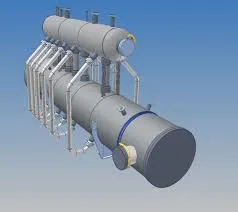China’s Growing Adoption of Gas-Fired Steam Boilers for Efficient Energy Production and Environmental Benefits
The Rise of Gas-Fired Steam Boilers in China
In recent years, China has been witnessing a significant shift in its energy landscape, driven by the need for cleaner energy sources and the reduction of greenhouse gas emissions. One of the most notable trends in this transition is the increased adoption of gas-fired steam boilers. These systems not only offer an effective means of producing steam for various industrial applications but also align with China's environmental goals.
Overview of Gas-Fired Steam Boilers
Gas-fired steam boilers utilize natural gas as their primary fuel source, which burns cleaner compared to traditional coal-fired boilers. This technology operates by converting the energy from gas combustion into steam, which is then used in power generation, heating, and industrial processes. The benefits of gas-fired steam boilers include higher efficiency levels, reduced emissions, and lower operating costs, making them an attractive option for industries looking to modernize their facilities.
The Role in China's Industrial Transformation
As China continues its rapid industrial development, the demand for steam in various sectors—such as textiles, food processing, pharmaceuticals, and chemical manufacturing—remains high. Traditionally, many of these industries relied heavily on coal-fired boilers, which have been major contributors to air pollution and carbon emissions. The transition to gas-fired steam boilers represents a crucial step in mitigating these environmental concerns while meeting the energy demands of a growing economy.
The Chinese government has recognized the importance of this transition. Policies aimed at reducing coal consumption and improving air quality have led to increased investments in gas infrastructure and incentives for industries to switch to cleaner alternatives. For example, the Ministry of Ecology and Environment has been actively promoting natural gas as a vital component of the country's energy mix.
Advantages of Gas-Fired Steam Boilers
china gsa gas fired steam boiler

1. Environmental Benefits One of the primary advantages of gas-fired steam boilers is their lower emission profile. When compared to coal, natural gas combustion produces significantly fewer pollutants, including sulfur dioxide (SO₂), nitrogen oxides (NOₓ), and particulate matter. This transition helps in addressing severe air quality issues in urban centers across China.
2. Efficiency and Cost-Effectiveness Modern gas-fired steam boilers are designed for higher efficiency, often exceeding 90%. This means that more of the energy content of the fuel is converted into useful steam. The operational cost savings—not only from fuel efficiency but also from reduced maintenance needs—can make gas-fired boilers a financially sound investment for businesses.
3. Regulatory Compliance As the Chinese government introduces stricter regulations on emissions, industries that utilize gas-fired boilers are better positioned to comply with environmental standards. This proactive approach can prevent costly fines and disruptions associated with non-compliance.
Challenges and Future Prospects
Despite these advantages, the transition to gas-fired steam boilers is not without challenges. Issues such as the initial capital investment, the availability of natural gas supply in certain regions, and the need for adequate training and maintenance of these advanced systems can pose barriers to widespread adoption.
However, the outlook remains positive. Continued government support, advancements in technology, and increasing awareness of environmental issues among industries will likely fuel the growth of gas-fired steam boilers in China. The shift towards natural gas aligns not only with national goals of reducing carbon footprints but also with global trends towards sustainability.
In conclusion, the rise of gas-fired steam boilers in China reflects a critical movement towards cleaner industrial practices. As the country navigates its energy transition, these systems will play a crucial role in modernizing industrial operations, improving air quality, and supporting economic growth, ultimately contributing to a more sustainable future.
-
Advanced Electric Steam Boiler Manufacturers | GPT-4 Turbo AINewsAug.01,2025
-
Custom Steam Boilers Manufacturer | AI-Enhanced EfficiencyNewsJul.31,2025
-
Top Electric Steam Boiler Makers | AI-OptimizedNewsJul.31,2025
-
Top Electric Steam Boiler Manufacturers - High Efficiency SolutionsNewsJul.30,2025
-
Top Electric Steam Boiler Manufacturers – Efficient Industrial SolutionsNewsJul.29,2025
-
Top Electric Steam Boiler Manufacturers | Reliable Industrial SolutionsNewsJul.29,2025

